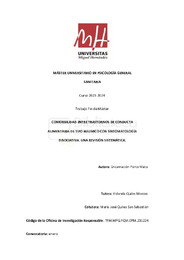Please use this identifier to cite or link to this item:
https://hdl.handle.net/11000/33765Full metadata record
| DC Field | Value | Language |
|---|---|---|
| dc.contributor.advisor | QUILES, YOLANDA | - |
| dc.contributor.advisor | Quiles Sebastián, María José | - |
| dc.contributor.author | Porto Mato, Encarnación | - |
| dc.contributor.other | Departamentos de la UMH::Psicología de la Salud | es_ES |
| dc.date.accessioned | 2024-11-04T09:24:12Z | - |
| dc.date.available | 2024-11-04T09:24:12Z | - |
| dc.date.created | 2024-01 | - |
| dc.identifier.uri | https://hdl.handle.net/11000/33765 | - |
| dc.description.abstract | Introducción: La sintomatología disociativa es frecuente en personas con bulimia, que puede ser explicada como una forma de hacer frente a emociones intensas que las personas no son capaces de manejar. Tanto la bulimia como la disociación pueden ser respuestas de afrontamiento a eventos traumáticos. Objetivo: Recopilar y conocer la información acerca de la comorbilidad entre la patología alimentaria de tipo bulímico con los trastornos o sintomatología disociativa. Metodología: Revisión sistemática siguiendo el Método PRISMA llevando a cabo una búsqueda en las bases de datos PubMED, PyscINFO, Scopus y Web of Science incluyendo estudios en inglés y español con un criterio temporal de 20 años. Resultados: Los datos sugieren que la disociación está significativamente relacionada con los trastornos alimentarios, mostrando variaciones en su intensidad y características específicas en diferentes subgrupos. Además, factores como el trauma y la gravedad de los episodios alimentarios parecen estar vinculados a la disociación Conclusión: Dado que la disociación puede ser un mecanismo mediador, es importante abordar de forma integral la disociación en el tratamiento de las personas con BN, ya que la sintomatología disociativa podría ser utilizada junto a los atracones y purgas para afrontar las emociones abrumadoras. | es_ES |
| dc.description.abstract | Introduction: Dissociative symptoms are common in people with bulimia, which can be explained as a way of coping with intense emotions that people are not able to handle. Both bulimia and dissociation can be coping responses to traumatic events. Objective: Compile and understand information about the comorbidity between bulimic-type eating pathology with dissociative disorders or symptoms. Methodology: Systematic review following the PRISMA Method, carrying out a search in the PubMED, PyscINFO, Scopus and Web of Science databases including studies in English and Spanish with a time criterion of 20 years. Results: The data suggest that dissociation is significantly related to eating disorders, showing variations in its intensity and specific characteristics in different subgroups. Additionally, factors such as trauma and the severity of eating episodes appear to be linked to dissociation. Conclusion: Given that dissociation can be a mediating mechanism, it is important to comprehensively address dissociation in the treatment of people with BN, since dissociative symptomatology could be used together with binge eating and purging to cope with overwhelming emotions. | es_ES |
| dc.format | application/pdf | es_ES |
| dc.format.extent | 40 | es_ES |
| dc.language.iso | spa | es_ES |
| dc.publisher | Universidad Miguel Hernández de Elche | es_ES |
| dc.rights | info:eu-repo/semantics/openAccess | es_ES |
| dc.rights | Attribution-NonCommercial-NoDerivatives 4.0 Internacional | * |
| dc.rights.uri | http://creativecommons.org/licenses/by-nc-nd/4.0/ | * |
| dc.subject | Disociación | es_ES |
| dc.subject | Bulimia | es_ES |
| dc.subject | Sintomatología disociativa | es_ES |
| dc.subject | Trastorno alimentario | es_ES |
| dc.subject | Atracones | es_ES |
| dc.subject.other | CDU::1 - Filosofía y psicología::159.9 - Psicología | es_ES |
| dc.title | Comorbilidad entre trastornos de conducta alimentaria de tipo bulímico con sintomatología disociativa. Una revisión sistemática | es_ES |
| dc.type | info:eu-repo/semantics/masterThesis | es_ES |

View/Open:
PORTO MATO TFM.pdf
924,14 kB
Adobe PDF
Share:
.png)
